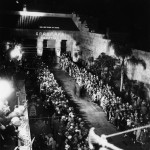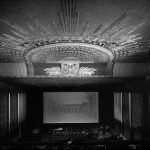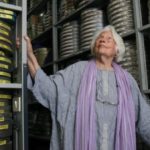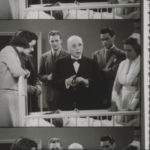Nitrate Film to Light Up the Egyptian Again
As we reported on 27 July 2016, the Egyptian Theater in Hollywood is undergoing renovations that will enable it to screen nitrate film regularly for the first time since the early 1950s. Here’s more on the project.
In the early years of motion pictures, movies were conveyed on nitrate film stock. That medium had a major shortcoming: it could burst into flame during projection.
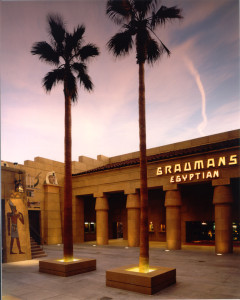
Egyptian Theatre, Hollywood. Photo: Tom Bonner
So, in 1951, so-called safety film, made from cellulose acetate, came into common use, and today nitrate is rarely screened – not only because it can readily burn, but also because very few cinemas remain that are equipped to screen it safely.
Last month [July 2016], however, a project got under way at the grand Egyptian Theatre on Hollywood Boulevard, built in 1922, to retrofit the projection booth with the capability to screen 35mm nitrate film prints. Completion of the project is scheduled for next month [September 2016].
The nitrate booth is being added so that the theater can show archival films in their original format, which had a variety of qualities lost in the move to safety stock. Projection specialists can and do argue until the cows come home about what the pluses and minuses of the original and later film stocks are, and what gives rise to them. For his part, filmmaker and archives benefactor Martin Scorsese made plain upon the announcement of the project that he believes the shift away from nitrate entailed a loss: “The silver content gave us a luminosity and a richness that was never quite matched by the safer stocks that followed or their digital reproductions,” he said.
Scorsese is founder and chair of the nonprofit The Film Foundation, which is one of several organizations backing the project, and which since 1990 has helped to restore almost 700 films. Alexander Payne, the Foundation’s director, said: “Nothing in theaters or on television today matches the thrill of seeing films on nitrate, and we should take full advantage of our being, sadly, among the last humans able to screen them.”
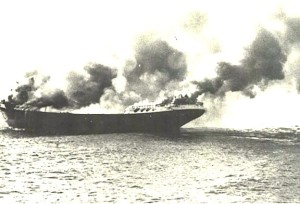
How volatile is a nitrate-film fire? In Australia in 1927, during production of the hugely successful “For the Term of his Natural Life,” about the country’s colonial convict era, the script called for a boat to catch fire. Infamously, the producers put in a call to vaults in Sydney and obtained enough nitrate stock to create this spectacle. Its drawback: up in flames went some unknown percentage of the country’s silent-film history.
The Egyptian occasionally screened nitrate film even through the beginning of this century, but changes in the city’s fire code in 2007 put an end to that, and it wasn’t until the code was again revised, this year [2016] that it could return. Leo Enticknap, who manages technical presentation of films and digital media at the Egyptian, explained in an entry on the Film-Tech Cinema Systems blog that the National Fire Protection Association’s code, NFPA 40, “was significantly revised in 2007 to toughen up the rules for any facility where nitrate is stored and used, with the result that the Egyptian’s booth was no longer nitrate legal. Making it legal per the 2007 version would simply not have been possible (it basically calls for a nuclear bunker-type facility …),” but under the 2016 version, “the requirements for theaters aren’t as stringent as those for archive facilities, reflecting the fact that a projection booth containing 6 reels of nitrate is less of an inherent danger than an archive vault containing 600,000. The 2007 NFPA 40 made no distinction between the two.”
The Egyptian’s booth project involves upgrading the walls of the current projection booth to enhance fire resistance, and installing a better ventilation system in the booth, wrote Enticknap, who works for American Cinematheque, which bought the Egyptian Theatre from the city of Los Angeles in the mid-1990s, for one dollar, and manages screenings there.
Joining it and The Film Foundation in the retrofit project is the Hollywood Foreign Press Association, which hosts its annual Golden Globe Awards at the Egyptian, and which this month announced a donation of $500,000 to the Egyptian, for maintenance and technical upgrades of the iconic theater, in addition to the $350,000 it is contributing to the nitrate-screening project. The maintenance-and-upgrade donation will be put to such uses as replacing the 10-year-old digital projector with a 4K projector, repairing some water damage to the building’s exterior and interior, and repainting the theater’s murals of Egyptian deities.
Also involved are Turner Classic Movies and the Academy Film Archive, which is among repositories that hold large collections of nitrate prints, which must be kept in controlled vault environments and are rarely screened because very few theaters can safely do so.
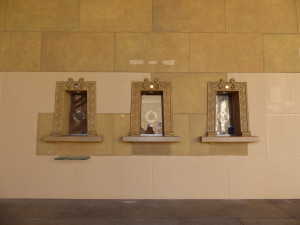
The Egyptian during its repairs in 1998. Photo: Margot Gerber
As a condition of its purchase of the Egyptian, American Cinematheque restored the theater and reopened its renovation of the exterior, interior, and exotic courtyard in 1998. The organization constructed a theater within the original theater, which Sid Grauman and developer Charles Toberman built in 1922 to a Meyer & Holler design as the first grand movie palace on Hollywood Boulevard. There, Grauman held the first ever Hollywood movie premiere.
The designer of the new, nitrate-safe projection booth at the Egyptian is BAR Architects, which also crafted the new Packard Humanities Institute film archive and screening facility in Santa Clarita, California, and the Library of Congress’ Packard Campus in Culpeper, Virginia. KCS West, the contractor for the Egyptian retrofit, has begun the work.
Rick Nicita, the chair of American Cinematheque, said the project will enable the organization to show every film format, from nitrate to the latest digital platforms.
Scorsese said: “I hope that this is the beginning of a trend.” That’s to say that he hopes the Egyptian is joining a trend by becoming only the second L.A. theater able to project nitrate; the other is the James Bridges Theater on the UCLA campus.
According to Enticknap, writing on the Film-Tech Cinema Systems blog, the fire-safety rules for projecting nitrate film needed revision in large part because projectionists inevitably became far less practiced at maintaining safeguards: “In 1930 nitrocellulose was an everyday substance, in widespread use. Just as anyone working in a gas station today has received training and uses it in minimizing the risk of accidental ignition, so did all projectionists in 1930 on how to prevent the accidental ignition of nitrate and manage the danger if it did happen. Only a tiny handful of film archivists, collectors, and workers in cinematheque-type venues have ever handled the stuff today, and public knowledge of fatal accidents such as the Glen Cinema fire and the Cleveland Clinic fire is almost non-existent. Any competent projectionist working in 1930 would have known all about them.”
{Click on an image to expand}
The Egyptian in all its 1922 glory. Photos: public domain, except right, by Juan Tallo, courtesy American Cinematheque.
n
The Cleveland Clinic fire killed 123 people, but caused only minor damage to the property, Enticknap explained. “Nitric-acid fumes were the reason why. The fumes from around 100 feet of burning 35mm are enough to kill you if inhaled — the inflammation in your windpipe caused by the acid will asphyxiate you.” Booths for projecting nitrate have exits directly to fresh air – to the theaters’ exteriors — because “you need to be able to exit the building in the time that you can hold your breath.”
Unsurprisingly, then, Enticknap and his colleagues at the Egyptian, where nitrate hasn’t been projected at all since the early ‘00s, and not regularly since around 1950, are reviewing all safety practices and procedures in time for nitrate’s August revival.
— Peter Monaghan
Previous Post: "Race Films" – Little-Known Screen Gems
Next Post: Restoring the One-Eyed with Blinkers On: The Curious Case of Marlon Brando’s Muddled Apprenticepiece


